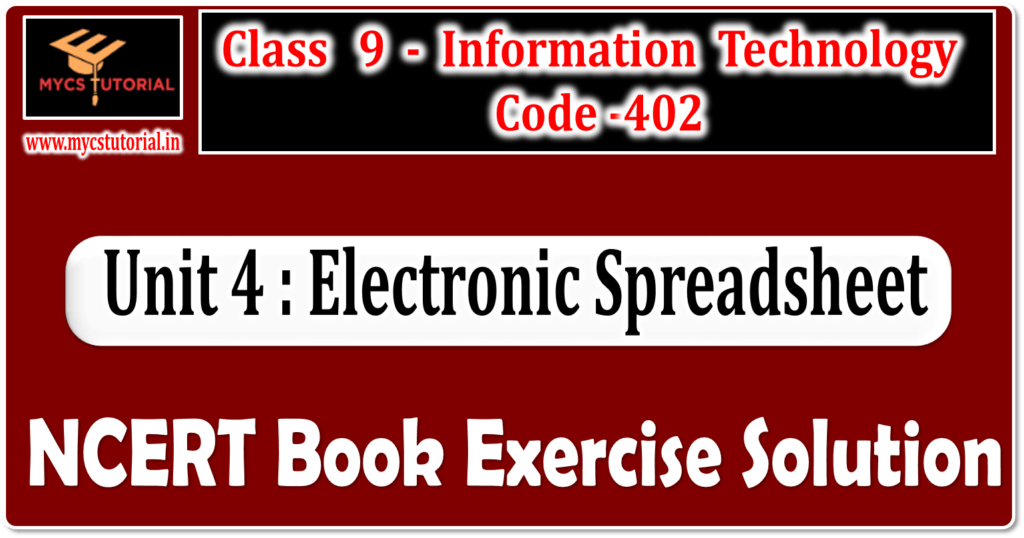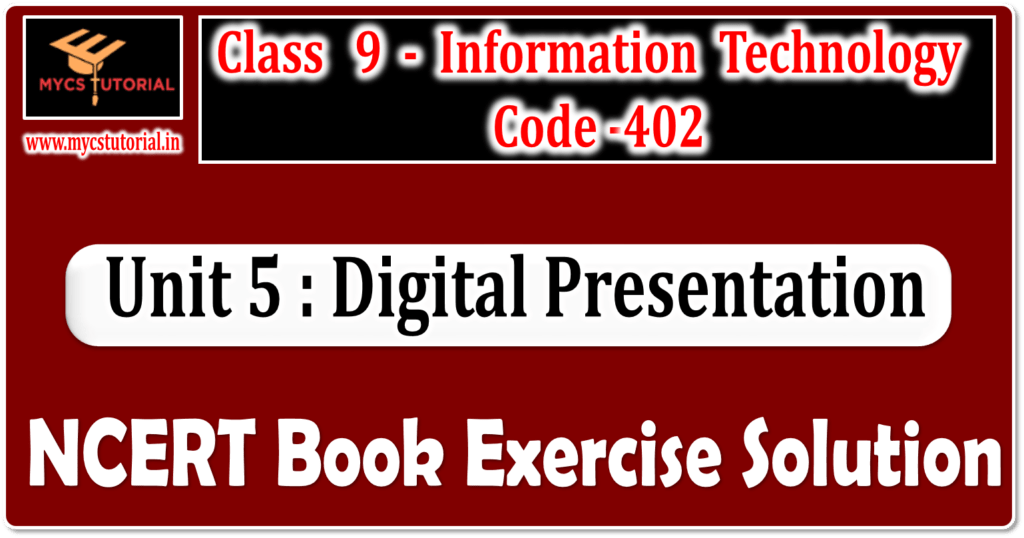Data Entry and Keyboarding Skills
A. Multiple-choice questions
1. Which of the following is not a key for punctuation marks?
(a) comma (,) (b) period (.) (c) semicolon (;) (d) equal sign (=)
Answer: (d) equal sign (=)
2. Which of the following is not an arrow key?
(a) top (^) (b) down (↓) (c) right (→) (d) left (←)
Answer: (a) top (^)
3. Which of the following operation is not performed by a mouse?
(a) Left Click (b) Right Click (c) Middle Click (d) Double Click
Answer: (c) Middle Click
4. In the Rapid typing tutor, which of the following is not true?
(a) Green letters denote right inputs.
(b) Yellow letters stand for right inputs in extra time.
(c) Red letters denote wrong inputs with in time.
(d) Orange letters indicate wrong inputs with in time.
Answer: (d) Orange letters indicate wrong inputs with in time.
5. The lesson control panel can be used for______________.
(a) animation (b) enable or disable sounds (c) plain (d) background
Answer: (b) enable or disable sounds
Data Entry and Keyboarding Skills Class 9 Book Solution
B. Fill in the blanks
1. A touch typist knows the location on the keyboard through _____ memory.
Answer: muscle
2. The typing speed is measured in _____.
Answer: WPM (Words Per Minute)
3. Alphabets (A–Z) and numbers (0–9) are known as _____ keys.
Answer: Alphanumeric
4. Del key deletes the character at the ____ cursor position.
Answer: Current
5. A standard keyboard has _____ Function keys.
Answer: 12
Data Entry and Keyboarding Skills Class 9 Book Solution
6. Numeric keypad is used to enter _____ data.
Answer: Numeric
7. Page Up key is used to shift the _____ one page up.
Answer: Cursor
8. Pressing the End key moves the cursor to the _____ character of the line.
Answer: last
9. On the numeric keypad ‘0’ is to be pressed by the _____ thumb.
Answer: right
10. The numeric keypad has ____ columns and ____ rows.
Answer: 4, 5
Data Entry and Keyboarding Skills Class 9 Book Solution
C. State whether the statements given below are True or False.
1. The Alt key is always used with the other key.
Answer: True
2. There are 5 arrow keys on the keyboard
Answer: False
3. The Backspace key is used to delete the character on the right to the cursor.
Answer: False
4. Caps lock key is a toggle key.
Answer: True
5. The control key is used in conjunction with other keys.
Answer: True
Data Entry and Keyboarding Skills Class 9 Book Solution
6. Enter key is also known as the Return key.
Answer: True
7. The function keys have different meanings in different software.
Answer: True
8. The keys ‘F’ and ‘J’ are known as guide keys.
Answer: True
9. There are two Caps Lock keys on the keyboard.
Answer: False
10. The mouse has two scroll buttons.
Answer: False
Data Entry and Keyboarding Skills Class 9 Book Solution
11. Page Down key is used to move the cursor on the next page.
Answer: True
12. Pressing the Home Key, moves the cursor to the first character in the document.
Answer: False
13. On a numeric keypad, the number 8 is the guide key.
Answer: False
14. In Rapid typing tutor, the right input entered is denoted by yellow color.
Answer: False
15. In Rapid typing tutor, the right input entered in exceeding time frame is denoted by Red colour.
Answer: False
D. Short answer questions (50 words)
1. Discuss the various types of keys available on a computer keyboard.
Answer: Various types of keys available on a computer keyboard are :
- Alphanumeric keys: All of the alphabet (A-Z) and numbers (0-9) on the keyboard.
- Punctuation keys: All of the keys associated with punctuation, such as the comma (,), period (.), semicolon (;), brackets ([]), parenthesis ({ }) and so on.
- Arrow keys: There are four arrow keys to move the cursor (or insertion point) up (↑), down (↓), right (→), or left (←).
- Shift or Alt keys: To move the cursor in more than one position at a time.
- Backspace key: Deletes the character just to the left of the cursor.
- Caps Lock key: It is a toggle key, which when activated, causes all alphabetic characters to be uppercase.
- Ctrl key: The control key is used in conjunction with other keys to produce control characters.
- Delete key: The Del key deletes the character at the current cursor position, or the selected object, but does not move the cursor.
- Enter key or Return key: It is used to enter commands or to move the cursor to the beginning of the next line.
- Esc key: The Escape key is used to send special codes to devices and to exit (or escape) from programs and tasks.
- Function keys: Special keys labeled F1 to F12. These keys have different meaning depending on which program is running.
2. Differentiate between Home Keys and Guide Keys.
Answer: Home Keys: Alphabets ASDF are home keys for the left hand and ; (semi-colon) LKJ for the right hand. The fingers are trained to make the correct movement to other keys and each finger returns immediately to its respective home key after pressing the corresponding key in any other row.
Guide Keys: On a computer keyboard, keys ‘F’ and ‘J’ are called guide keys for left and right hand, respectively. Both contain a small raised tangible mark with the help of which the touch typist can place the fingers correctly on the home keys.
3. What do you understand by Guide Keys? Name the Guide keys of a
(a) computer keyboard
(b) typewriter
Answer: Those keys which help in the placement of fingers on Home keys is called guide key.
a) On a computer keyboard, keys ‘F’ and ‘J’ are called guide keys for left and right hand, respectively.
b) On a typewriter, the two keys ‘a’ and ‘(semi-colon) ;’ are called guide keys which are depressed with left and right hand little finger respectively.
4. Explain the role of typing ergonomics.
Answer: Typing ergonomics provides logistic support for efficient and effective typewriting. They are important to attain and maintain accuracy and speed. Some of these factors included are as given below.
- Sitting posture: While operating the computer keyboard, sit straight, slightly bending your neck forward.
- Position of hands: Put your forearms at level with the keyboard and palms down.
- Monitor placement: Do not bend your neck while working on the monitor.
- Mouse and keyboard placement: Keep the keyboard and mouse together at an approximate distance of 20 cms, which will help in smooth and effortless operation of keyboard.
5. Why the use of various typing software is common now-a-days?
Answer: Uses of typing software:
There is many free typing software available that can be customized according to our requirement and help to learn typing.
It is designed to learn typing skills on the computer.
6. Mention the finger allocation of keys in the Bottom Row of a computer keyboard.
Answer: Keys Z, X, C, V, B, N, M, Comma, Full Stop, and ‘/’ signs are located on this row.
- From the Home Row, turn downwards the Ring Finger of left hand and strike key ‘z’. Similarly, type keys ‘x’ and ‘c’ with the middle and forefinger, respectively.
- Type full stop, comma, m, n with little, Ring, Middle and forefinger of the right hand, respectively, which will appear as z x c . , m n
- Alphabets ‘v’ and ‘b’ are to be typed with forefinger of left and right hand, respectively
Class 9 Information Technology Code 402 – NCERT Book Solution
- Introduction to IT and ITES Industry
- Data Entry and Keyboarding Skills
- Digital Documentation
- Electronic Spreadsheets
- Digital Presentation
By Anjeev Kr Singh – Computer Science Educator
Published on : August 31, 2022 | Updated on : June 3, 2024






